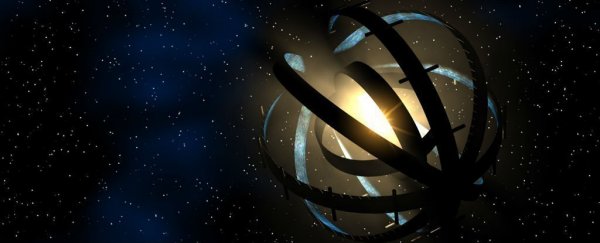We all knew it was coming, and it might finally be here - scientists say they have a solution to the 'alien megastructure' star that doesn't involve aliens, and unlike previous explanations, this one is extremely consistent with previous observations of the star's activity.
The solution doesn't involve dubious comet swarms or interstellar junk, but instead suggests that the star is undergoing an internal phase transition, which is causing powerful outbursts on the surface that are occasionally blocking the light emissions that our telescopes detect.
In other words, instead of something else getting in the way of the star and blocking its light from us, this new study suggests that internal conditions in the star itself are causing the dips in its brightness.
In case you have no idea what all this 'alien megastructure' business is, back in October 2015, scientists discovered a strange pattern of light surrounding a distant star called KIC 8462852, and it was like nothing we'd ever seen before.
When a planet orbits a star, the star's brightness will periodically dip by around 1 percent, but KIC 8462852 has been experiencing erratic dips of up to 22 percent. This immediately got scientists speculating that something very, very big had been zooming past it.
A massive swarm of comets was thrown out there as an explanation, but that's been more or less debunked. More recently, researchers have suggested that the bizarre dimming is the result of some kind of clutter in interstellar space.
The there was the now-notorious suggestion from Jason Wright, an astronomer from Penn State University, that the solution could be something from the realm of science fiction - a gigantic Dyson Sphere made of solar panels that completely encircles a star.
"Aliens should always be the very last hypothesis you consider, but this looked like something you would expect an alien civilisation to build," he told The Atlantic last year.
But no explanation - aliens or otherwise - has fit the data well enough to convince the scientific community to run with it, so the 'alien megastructure' star remained shrouded in mystery.
Until now, perhaps, because a team from the University of Illinois says we've been looking at the problem all wrong, and a different perspective could give us a pretty solid answer to KIC 8462852's weirdness.
The researchers have been studying how the star's large and small dips in brightness relate to each other, and when they applied a number of mathematical models to the data, they came up with patterns that also appear in what's known as avalanche statistics.
Avalanche statistics have turned up in all kinds of natural phenomena, including solar flares, gamma-ray bursts, and neural activity in the brain, and while the maths is pretty complicated, in basic terms, it reveals patterns where small dips in the data occurring between the larger dips ultimately equate to even larger dips.
Avalanche statistics appear to be associated with things going through certain phase transitions - most commonly between solid, liquid, and gaseous states of matter, and in rare cases, plasma.
"Examples of such transitions are magnetic systems that are slowly driven with a magnetic field, or the slow deformation of somewhat brittle materials where there is often first little crackling that gets louder and louder until there is a big snap when the material breaks," says one of the team, Karin Dahmen.
"The small events in our star analysis would be like the little crackles while the large events would be the analogue of the big snap."
Phase transitions are thought to be associated with solar activity such as solar flares and solar storms, so it could be that KIC 8462852's internal materials are transitioning, and the result is erratic outbursts that block its light.
"Their analysis shows that the avalanche model is extremely consistent with what's observed," astrophysicist Ethan Siegel explains for Forbes.
"In other words, this could just be a star that's intensely active in some poorly understood way, giving off periodic massive outbursts that cause a dimming of the light. And the fact that stars like this are rare is what's been fooling us all along."
Only time will tell if this is the right answer, but it's fitting the existing data pretty nicely so far.
And even if KIC 8462852 doesn't ultimately live up to its "Aliens!" hype, we still have a phenomenon on our hands that's like nothing we've ever seen before, and that's awesome.
The study has been published in Physical Review Letters.
